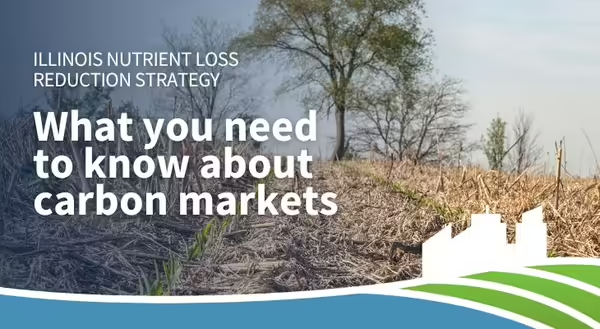
Did you know that there are other ecosystem markets out there that aren’t carbon markets? With the increasing number of players and frequent changes in ecosystem markets, there is a lot of uncertainty. In the February 2022 episode of the Illinois Nutrient Loss Reduction Podcast, we talked to Jack McCormick, an Illinois farmer who is part of a carbon market, and his advice to those interested in joining a market. In addition, we discussed other ecosystem markets, some of the players, and ways to evaluate different opportunities with Jean Brokish, Midwest Program Manager with American Farmland Trust and member of the Illinois Sustainable Ag Partnership (ISAP).
Jack McCormick is a fourth-generation farmer who lives and farms corn, soybeans, wheat, and beef cattle in Ellis Grove, Illinois. On their farm, Jack’s family has been practicing no-till since 1970, with 100% of their acres being no-till since 1990; they also incorporate terraces and cover crops into their system.
After frequently hearing about carbon markets from newspapers and magazines, Jack decided it was a good idea to investigate carbon markets to get paid for the practices he was interested in if it was manageable on the paperwork or demands. After doing his research, Jack enrolled in two carbon programs in the fall of 2020 for the 2021 crop year, which inspired him to start a new practice- cover crops.
Jean Brokish, Midwest Program Manager with American Farmland Trust, provides coordination to ISAP, explaining the group as a thirteen-member organization all working collaboratively, sharing research, information, messaging, and sharing resources to build better capacity and make progress towards the Illinois Nutrient Loss Reduction Strategy. Members of ISAP, including Jean, were contacted by market representatives wanting to share information with their farmer partners, which inspired the ISAP Ecosystem Markets Webinar series and information fact sheet.
Jean defines carbon markets as the buying and selling of the reduction of greenhouse gasses. She continues by explaining that a company or industry may have a sustainability or climate goal, but if they do not have the capacity to reduce enough greenhouse gases in-house, they must look to outside sources. The transaction between the external sources is where the market space is created.
Overall, Jean’s advice for farmers and landowners is to set realistic goals, understanding that the perception that these programs will make them a lot of money does not always match the reality. Additionally, Jean adds that individuals must read and understand the contract they are entering while maintaining accurate records.
ABOUT THE AUTHORS
Rachel Curry is a Watershed Outreach Associate for two Nitrogen Priority Watersheds (Flint-Henderson and Lower Rock River Watersheds) and is housed in the Galva office of the Henry, Mercer, Rock Island, and Stark Counties Extension Unit. Rachel earned a BS in Environmental Studies from Knox College and an MS in Environmental Science and Soil Science from Iowa State University with an emphasis on soil fertility. She is interested in sharing information on the Illinois Nutrient Loss Reduction Strategy and agricultural conservation practices through discussion and outreach.
Nicole Haverback is a Watershed Outreach Associate for two Phosphorus Priority Watersheds (Embarras and Little Wabash River Watersheds) and is housed in the Effingham office of the Clay, Effingham, Fayette, and Jasper Counties Extension Unit. Nicole earned a BS in Agriculture and Rural Policy Studies from Iowa State University in May of 2022. She is interested in sharing information on the Illinois Nutrient Loss Reduction Strategy and agriculture conservation practices through discussion and outreach.
ABOUT THE BLOG
At Illinois Extension, we’re working to improve water quality at home and downstream. Every month, our watershed outreach associates will bring you stories highlighting agricultural conservation practices, current research projects and results, and from the field farmer interviews. The Nutrient Loss Reduction blog covers conservation practices recommended by the Illinois Nutrient Loss Reduction Strategy, timely updates, farm safety, and new decision tools to help farmers and producers reduce the nutrients leaving their field. Want to get notified when new blog posts are available? Subscribe at go.illinois.edu/SubscribeINLRS.